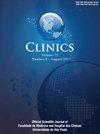苏珊娜UF假体治疗难治性先天性青光眼的疗效
IF 2.4
4区 医学
Q2 MEDICINE, GENERAL & INTERNAL
引用次数: 0
摘要
目的评价Susanna UF青光眼引流装置(SUFGDD)治疗难治性原发性先天性青光眼的成功率和并发症发生率。患者和方法在这项前瞻性非比较临床试验中,顽固性原发性先天性青光眼患者,年龄在18岁以下,既往青光眼手术不成功,接受了标准化的SUFGDD植入手术。所有手术均由一名外科医生(A.D.P.R.)完成。记录术前和术后眼压(IOP)、抗青光眼滴眼液次数、手术并发症及任何后续相关事件。成功标准定义如下:(1)IOP≥5且≤21 mmHg;(二)IOP≥5,≤18mmhg。每组进一步分类为绝对成功(未用药)或合格成功(包括用药)。结果纳入31例患者45只眼,平均年龄6.14±5.02岁(9个月~ 18岁)。平均随访时间37.78±10.44个月。平均眼压由28.18±5.69 mmHg降至14.73±2.90 mmHg (p <;0.05)。抗青光眼药物的平均用药次数从2.96±0.74次减少到1.40±1.23次(p <;0.05)。术后36个月,标准I和II的合格率分别为93.3%和77.8%。7眼(15.6%)出现并发症,均需再次手术;6例手术成功,1例因眼内炎导致永久性视力丧失。并发症与分析的危险因素(如既往手术次数、手术年龄、既往青光眼手术、术前IOP和术前滴眼液次数)之间无显著关联。然而,在标准II的合格成功组中,观察到并发症的发生与手术失败之间存在关联(HR = 6.50;95% ci 1.20-31.35;P = 0.029)。结论在本研究队列中,SUFGDD在36个月时,标准I和II的成功率分别为93.3%和77.8%,并发症发生率为15.6%。本文章由计算机程序翻译,如有差异,请以英文原文为准。
Outcomes of Susanna UF implants in refractory congenital glaucoma
Objective
This study aimed to evaluate the success and complication rates of the Susanna UF Glaucoma Drainage Device (SUFGDD) in treating refractory primary congenital glaucoma.
Patients and methods
In this prospective non-comparative clinical trial, patients with refractory primary congenital glaucoma, under 18-years-old, who had unsuccessful prior glaucoma surgeries, underwent standardized SUFGDD implant surgery. All procedures were performed by a single surgeon (A.D.P.R.). Pre and postoperative intraocular pressure (IOP), number of antiglaucoma eye drops, surgical complications, and any subsequent related events were recorded. Success criteria were defined as follows: (I) IOP ≥ 5 and ≤ 21 mmHg; (II) IOP ≥ 5 and ≤ 18 mmHg. Each group was further categorized as absolute success (without medication) or qualified success (including those with medication).
Results
The study included 45 eyes from 31 patients, with an average age of 6.14 ± 5.02 years (range: 9 months‒18 years). The mean follow-up time was 37.78 ± 10.44 months. Mean IOP decreased from 28.18 ± 5.69 mmHg to 14.73 ± 2.90 mmHg (p < 0.05). The average number of antiglaucoma medications was reduced from 2.96 ± 0.74 to 1.40 ± 1.23 (p < 0.05). At 36-months postoperatively, the qualified success rates for criteria I and II were 93.3 % and 77.8 %, respectively. Seven eyes (15.6 %) experienced complications, all of which required reoperation; six cases were successfully managed, while one case resulted in permanent vision loss due to endophthalmitis. There were no significant associations between complications and analyzed risk factors (e.g., number of previous surgeries, age at surgery, past glaucoma surgeries, preoperative IOP, and number of preoperative eye drops). However, an association was observed between the occurrence of complications and surgical failure in the qualified success group for criterion II (HR = 6.50; 95 % CI 1.20‒31.35; p = 0.029).
Conclusion
In this studied cohort, SUFGDD achieved qualified success rates of 93.3 % and 77.8 %, for criteria I and II, respectively, at 36-months, with a complication rate of 15.6 %.
求助全文
通过发布文献求助,成功后即可免费获取论文全文。
去求助
来源期刊

Clinics
医学-医学:内科
CiteScore
4.10
自引率
3.70%
发文量
129
审稿时长
52 days
期刊介绍:
CLINICS is an electronic journal that publishes peer-reviewed articles in continuous flow, of interest to clinicians and researchers in the medical sciences. CLINICS complies with the policies of funding agencies which request or require deposition of the published articles that they fund into publicly available databases. CLINICS supports the position of the International Committee of Medical Journal Editors (ICMJE) on trial registration.
 求助内容:
求助内容: 应助结果提醒方式:
应助结果提醒方式:


